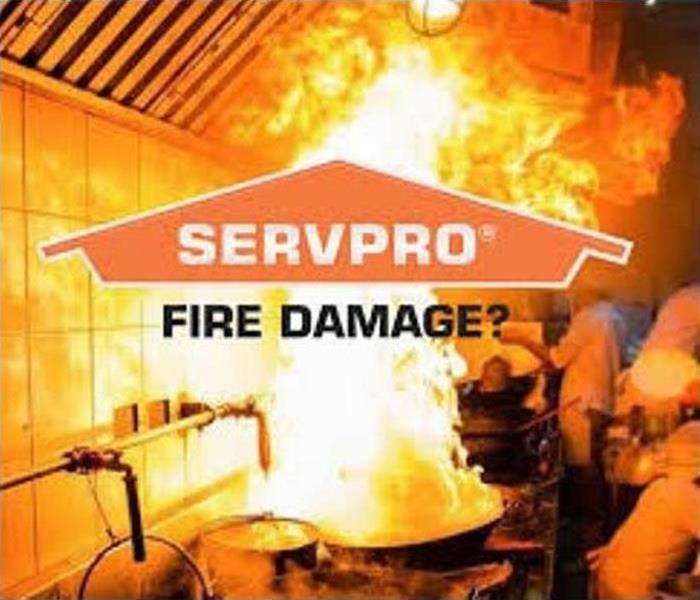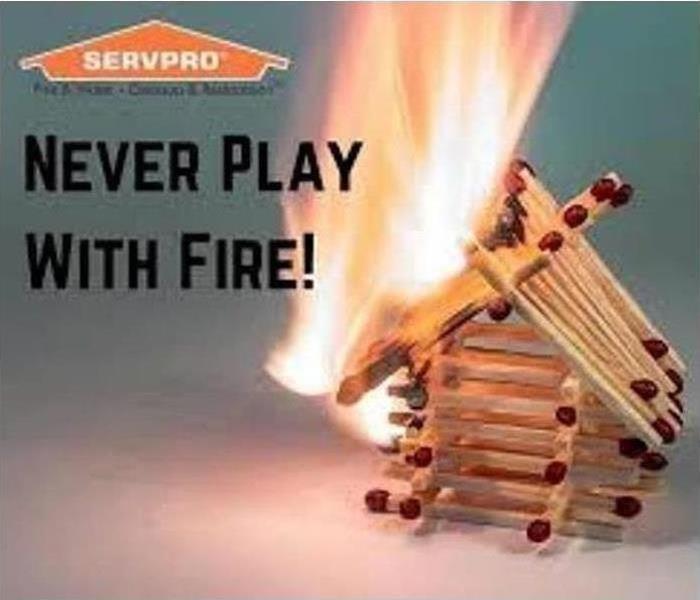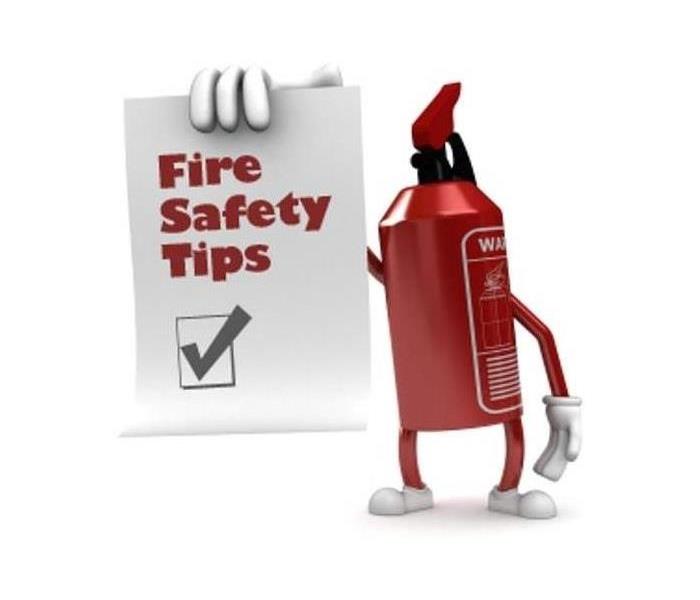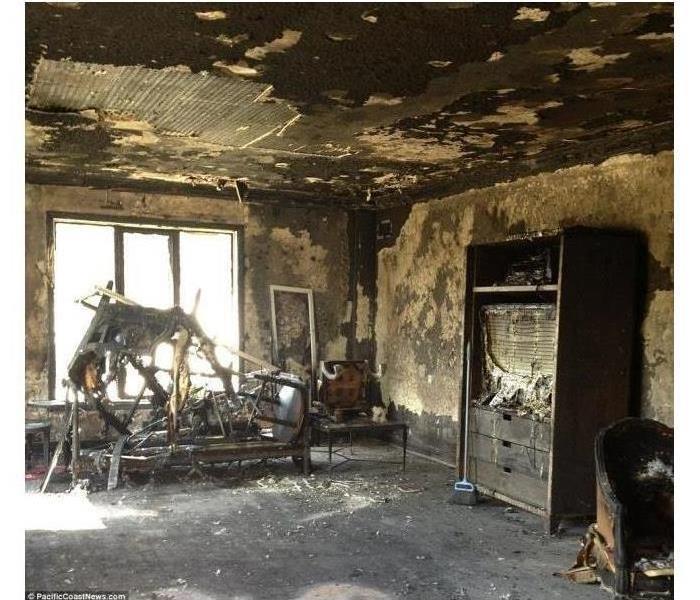Archived Fire Damage Blog Posts
Top Fireproofing Solutions for Homeowners
3/28/2025 (Permalink)
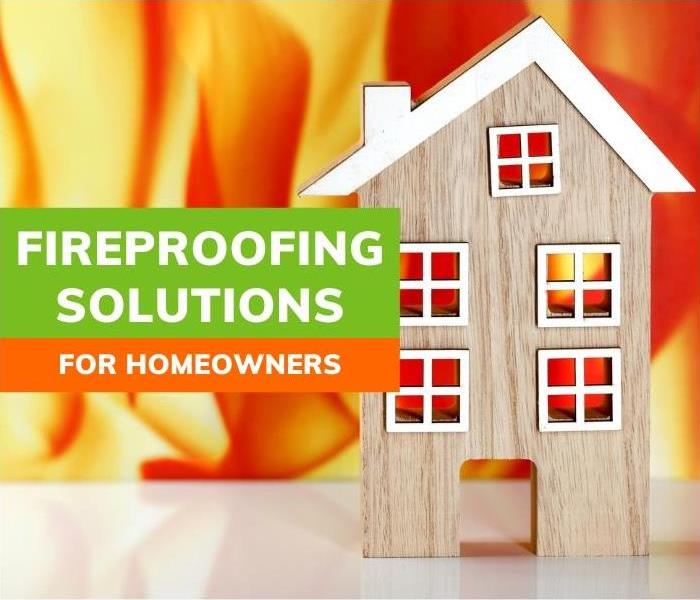 Model house in front of a fire
Model house in front of a fire
Top Fireproofing Solutions for Homeowners
Fire safety measures are critical for homeowners, especially those in fire-prone areas. Proactively fireproofing a home helps maintain its value while protecting its precious occupants.
Whether upgrading insulation or reworking the garden with fire-resistant plants, investing in these solutions can provide the vital seconds or minutes that make all the difference in an emergency.
Add Fire-Rated Insulation
Remove the home's existing insulation and install a safer, fire-rated product. This adds significant protection by hindering the spread of flames. Insulation materials like non-combustible mineral wool or ceramic fiber increase a home's resistance to high temperatures.
While the insulation slows the spread of fire, it also provides more time to safely remove loved ones from the structure and respond effectively to the threat. Fire-rated insulation complies with local safety regulations and may be required in critical spaces such as stairwells. As a bonus, fire-rated insulation also improves the home’s energy efficiency.
Integrate Fire-Resistant Materials
Various materials, such as fire-retardant coatings and fire-resistant building materials, offer enhanced protection. Some of the best fire protection comes from concrete, stucco, gypsum, and brick exteriors. Top home fireproofing solutions include using coatings made explicitly for wood surfaces, such as fire-retardant paint or primer coatings.
Add a clear fire-retardant coating to any surface to enhance a home's structure and aesthetics. This treatment extends the time for materials to ignite when exposed to flames. Retardants also reduce the ability of fire to spread to nearby structures. The coatings can be reapplied during periodic maintenance for continued protection.
Use Protective Building Materials
Renovating an existing home using fire-safe materials gives an extra layer of protection. Choose non-combustibles such as fiber cement siding, concrete, or certain types of stone, such as sandstone. Consider green solutions such as Timbercrete, made of recycled timber cellulose, which has natural fire-resistant properties and reduces the building’s carbon footprint. Metal and reinforced concrete building elements can add aesthetic beauty and additional protection.
Ensure the renovations adhere to local building codes and standards and choose tested certified products. Pay attention to whether materials are fire-resistant or fire-retardant. Fire-resistant materials are inherently resistant to catching fire, so they self-extinguish flames and do not drip or melt if exposed to heat. Fire-retardant materials have been treated with chemicals to make them self-extinguish, but the coating may need reapplication over time.
Invest in Fire-Resistant Windows and Doors
Fire-resistant windows and fire-rated doors help safeguard interior spaces as critical barriers to slow fire spread into and within a structure. Choose engineered glass windows that can withstand high temperatures and thermal shock without breaking. During a fire, the rapid temperature change can cause standard windows to break, allowing heat and flames to penetrate the home.
These windows typically have double panes that distribute heat more evenly and better protect against flames. The double panes also act as insulation for the home, increasing comfort and overall energy efficiency.
Fire-rated doors significantly slow the spread of fire into or within a home. They can withstand high temperatures and often come with seals to prevent smoke infiltration. Interior fire-rated doors can close off different areas, making it easier to contain flames, heat, and smoke. They also aid in safer exits during emergencies, making them one of the top fireproofing solutions for homeowners. After a fire, the home may require professional smoke damage services, and closing off sections with fire-rated doors can keep the damage and restoration work to a minimum.
Install Automatic Fire Sprinklers
Automatic home fire sprinkler systems provide a critical safety function by suppressing flames as soon as a fire starts. According to FEMA, fire sprinklers and smoke alarms reduce the risk of individuals dying in fires by 82%. Home fire sprinklers activate by sensing temperature changes, spraying only in the area of a fire. They reduce the flame, smoke, and heat, which makes it safer for home occupants and firefighters.
The systems can be installed during a renovation and are flush with the ceilings. Sprinklers minimize fire-related property damage and cause less destruction than water damage from firefighting hose lines.
Incorporate Advanced Systems for Fire Detection
Detecting a fire early can make all the difference between a minor event and catastrophic damage. Smoke alarms usually last about 10 years, so when it’s time for replacements, add heat and standard smoke detectors. Consider systems that have smart features, such as a mobile phone app that sends immediate notifications.
Ensure the sensors or detectors are inspected about once per month and tested periodically for proper maintenance. Place the detectors in strategic positions throughout the house and link them so that all the detectors sound if one sounds. Consider that once a smoke alarm sounds, home occupants may have less than two minutes to evacuate to a safe space.
Make Outdoor Spaces Defensible
Wildfires move quickly; something as small as a flying ember can endanger homes. Creating defensible space around the outside of a home reduces the risk of catching fire, which is another of the critical top fireproofing solutions for homeowners. Remove flammable debris and vegetation from yard areas around the structure. Create a buffer zone around the home using non-combustible materials such as gravel, concrete paths, patios, and stone retaining walls.
Avoid using combustible mulch in or around plant beds. Instead, substitute it with non-combustibles such as pea gravel or decomposed granite. Enhance the garden with fire-resistant plants, like succulents, agave, ice plants, and aloe. These plants retain moisture, resist burning, and act as a barrier to stop fire from spreading. Add fire-resistant shrubs and trees, keeping them trimmed and at least 10 feet from the home and potential sparks from a chimney.
Strategic Upgrades Provide Peace of Mind
Implementing solutions to make a home fire-proof is an essential investment for any homeowner. From installing fire-retardant building materials to adding home fire sprinklers, these upgrades can enhance safety and reduce the risk of fire damage.
As part of your home maintenance or fire restoration plan, add services like residential air duct cleaning to remove smoke, dust, and odors and to improve interior air quality. SERVPRO®'s qualified professionals can help you proactively keep your home safe and secure against fire. Contact us today for more information.
Post-Fire Cleanup What to Do Next
3/5/2025 (Permalink)
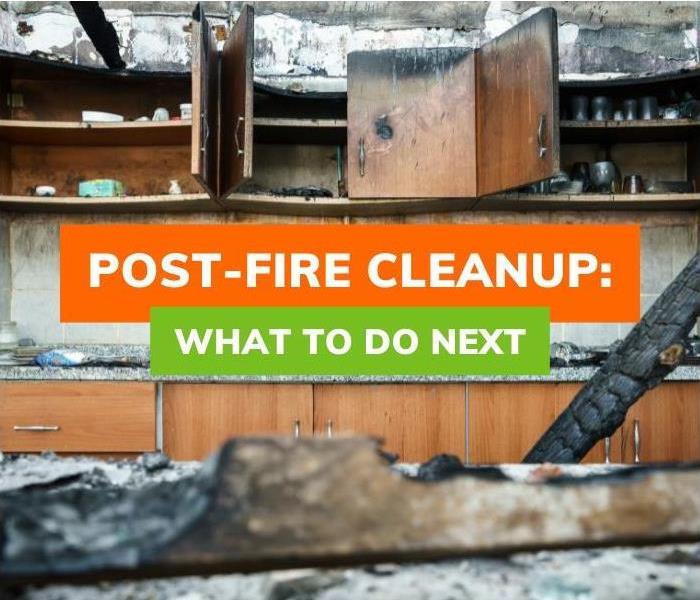 Kitchen after fire damage
Kitchen after fire damage
Post-Fire Cleanup What to Do Next
Having a home or commercial property exposed to fire is traumatic and can cause devastating losses. For properties that remain partially intact, restoration can seem dangerous and overwhelming. Following a process that focuses on safety and essential restoration steps can ensure the restoration work takes place with less stress.
1. Put Safety First
What should be done next for post-fire cleanup? After a fire, it is essential to prioritize personal safety before entering the building to start the cleanup process. Adopt protective gear, including an N95 mask or respirator, safety goggles, durable gloves, and sturdy shoes or work boots. Wear protective clothing that fully covers arms and legs.
Survey the property before entering, noting any visible structural damage that could make cleanup efforts unsafe. Avoid inhaling fumes or ash from soot-covered surfaces, and keep touching to a minimum to avoid toxic byproducts produced from the burned materials if you are not wearing gloves.
Pay attention to other potential hazards that could surface during the cleanup, such as gas leaks, exposed wires, and electrical hazards.
Avoid bringing family or pets inside the building until it has been thoroughly inspected, cleaned, and deemed safe for entry.
2. Notify the Insurance Company
The claims process can become time-consuming, so contact the insurer early to ensure prompt coverage and the necessary funds to cover needed repairs. Request that an adjuster come out to inspect as soon as possible and document all damage with photographs and video footage to share with them.
Ask for a copy of the insurance policy to learn what the coverage includes. To avoid complications with insurance coverage or reimbursement, do not make any permanent repairs to the structure until the insurance company has assessed the damage. In the meantime, keep all receipts for hotels or other temporary housing, food, and other expenses incurred while away from home.
3. Protect the Building
Unfortunately, intruders may attempt to enter burned structures after a fire, looking for valuables. To keep them out, board up broken windows and doors. Also, remove any valuables and important items that are salvageable.
For post-fire cleanup, what to do next includes turning off the water, gas, and electricity until inspectors can survey the property and ensure its safety. However, if the electrical panel or breaker looks damaged, wait for a professional to handle it. Any hissing sounds or gas smell could indicate a gas leak. In this case, leave the property immediately and contact the fire department. If the home's roof is damaged, cover it with an anchored tarp to keep moisture out in case of rain.
4. Assess the Building's Structural Integrity
It is essential to examine structures damaged by fire before entering. Certain weaknesses can endanger workers or hinder cleanup efforts. Look at the building’s major support beams and load-bearing walls for signs of charring. Inspect the ceilings, walls, and floors for visible cracks or signs of shifting. Additionally, check the building's foundation for signs of shifting, cracks, or other instability.
5. Address Water and Mold
Water used to extinguish a structure fire can create secondary problems if the building materials remain wet or the floor has pooling water. Mold growth can begin within 24 hours, making it essential to remove standing water as quickly as possible. Accelerate the drying-out process with the aid of large fans and dehumidifiers.
Dispose of waterlogged materials or belongings that cannot be salvaged, such as carpeting, drapes, or furniture. Treat the affected areas promptly with an especially formulated antimicrobial solution to discourage mold growth. Remember to inspect hidden areas, such as insulation and crawl spaces, for moisture that needs drying.
6. Restoration for Smoke Damage
Even if a house has not sustained fire damage, the smoke, ash, and other residue from a nearby fire can severely impact the home's internal air quality and leave toxic residues behind. For post-fire cleanup, what to do next includes immediately airing out the property by opening all windows and running air purifiers, such as those using high-efficiency particulate air (HEPA) filters. Wipe down all surfaces in the home with cleaners formulated to remove soot.
Smoke damage restoration includes hidden areas, such as the home's air ducts, which may require professional cleaning to remove debris and odors.
Dry-clean or wash all fabrics, including clothing, linens, and upholstery.
While waiting for odors to subside, minimize them by masking them with baking soda, activated charcoal, non-toxic air fresheners, or quality essential oils. If the odors persist, consider scheduling a professional ozone treatment.
7. Assess Salvageable Items
After a fire, some burned materials, such as charred or melted electronics, can release toxic or hazardous chemicals. Investigate local waste disposal guidelines to ensure these items are properly removed and disposed of. In some cases, metals and other materials can be recycled and repurposed, keeping them from going to landfills.
Separate belongings and furnishings that are beyond repair from those that can be restored. For example, professionals can often restore furniture with minor damage. Appliances and electrical wiring may appear fine, but it is essential to inspect them for exposed or melted areas and have outlets and circuits tested by a licensed electrician before use. Replace any appliances that have warped, scorched, or melted cords or plugs.
8. Plan Long-term Restoration Projects
Restoration work after a fire can take time, so create a clear plan to stay on track, efficient, and organized. Attack essential projects such as electrical, roofing, and plumbing first. Work with contractors who have experience with fire damage and restoration.
Use renovation materials with fire-resistant properties for roofing, walls, and insulation. Consider adding fire-rated doors and windows with tempered glass that can withstand high heat without shattering. Additional home upgrades include sprinkler systems and exterior plantings of fire-resistant trees, shrubs, and ground cover.
Ensure Quality Restoration After a Fire
In the event of fire damage, your home or commercial building may need multiple restoration projects completed. Healthy air quality is crucial, and air duct cleaning services ensure smoke odors, ash, and other debris are eliminated. Call on the professionals at SERVPRO® to restore your property after a fire. We will help return your home to a safe and healthy living place. Contact us today.
Steps to Restore a Property After Smoke Damage
1/23/2025 (Permalink)
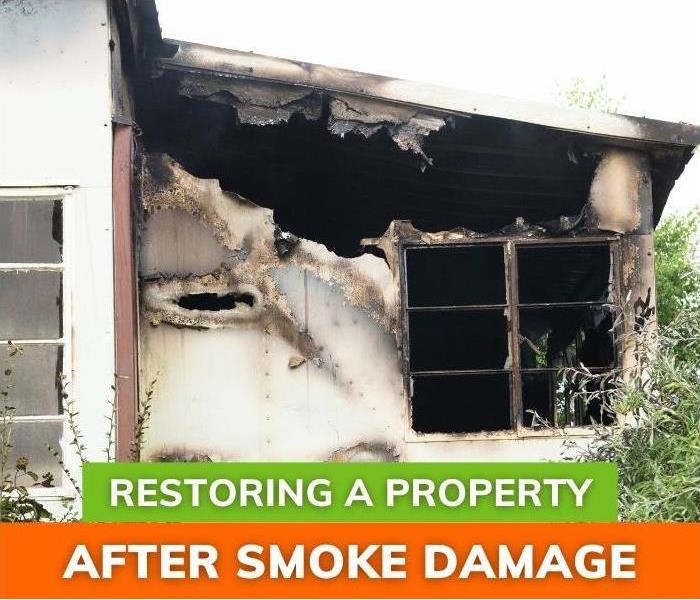 House damaged caused by fire
House damaged caused by fire
Steps to Restore a Property After Smoke Damage
A fire at your home or business can be one of the most frightening and traumatic experiences you’ll ever go through. In addition to the danger structure fires pose, they often result in the loss of property, some of which may include irreplaceable memories.
In addition, the lasting effects of water, fire, and smoke damage can lead to ongoing issues like structural instability, bad indoor odors, discoloration of interior spaces, and mold growth. While your safety and the safety of loved ones should always be paramount when picking up the pieces after a fire, there are some things you can do to make the restoration process easier.
If you’ve experienced the damaging effects of a home or business fire and you’re not sure of your next move, below are some steps to restore a property after smoke damage:
Be Mindful of Structural Stability
Because your safety is of the utmost importance and fires can weaken structures, never enter a structure that has experienced fire or water damage until it has been inspected by a qualified professional. Even if an area looks safe, hidden damage may be present if water, flames, and smoke have penetrated walls, flooring, and ceiling areas.
When these areas have been affected, you may not realize how weak a supporting wall or piece of flooring is until it fails. When it comes to damage restoration after a fire, your first goal should always be to secure the property before beginning to deal with things like smoke odors. While smoke and soot are bothersome and should be addressed, you need to make sure the affected area is safe to enter before you can begin the process of remedying a damaged property.
Contact Your Insurance Company
When possible, you should try to inspect structural damage in a safe manner, but you’ll also want to contact your insurance company to discuss the claims process. Insurance companies can tell you which parts of the structure are covered for loss and can walk you through the insurance claims process.
If possible, take photos and video of any damage you can see. Once again, be mindful of structural stability, and never place yourself in harm’s way when trying to assess the extent of the damage. If required, your insurer will send someone to your home or business to officially document any damage for the claims process.
Keep in mind that the insurance claims process can be lengthy, so you may need to make alternate plans to address immediate concerns. Depending on the extent of the damage, you and your loved ones may need to vacate a property until it can be properly inspected and repaired by a professional.
Document any work you have completed on the structure while going through the insurance claims process. This can help you and your insurer keep track of all payments made pursuant to any claims.
Work With Restoration Professionals
Although you can do things like install air scrubbers to remove odors in a fire-damaged home or business, most people benefit from partnering with fire and smoke damage restoration professionals to alleviate major issues. Companies that specialize in water damage restoration can take care of wet cleaning and smoke odor remediation, and most also provide thorough inspection and cleaning services for hidden dangers like mold.
As an added bonus, these companies have specialized tools and equipment to restore structural elements damaged by water used to put out a fire. Water damage restoration is often an involved process since moisture can seep into walls, flooring, and other areas of a home or business.
Simply drying affected areas is not enough, as damage may affect various layers of surfaces. Professional damage restoration services experts are able to take care of smoke and water damage on the surface, but they’re also able to clean and restore areas that may not be seen by the naked eye.
Be Mindful of Cleaning Products
If you choose to clean some of your property on your own, be mindful of which cleaning products you use. While cleaning is one of the steps to restore a property after smoke damage, not all cleaning products are designed for safe use on surfaces damaged by fire, smoke, and water. Some cleaning products may react to changes in a surface’s chemical composition following damage, and this can cause a cleaning agent to cause further damage.
If you use cleaners, try to use products that contain natural ingredients. It’s also a good idea to review the directions of any products you use and consider contacting the cleaner’s manufacturer to inquire about usage.
You’re also encouraged to test any cleaning products in an inconspicuous area before using them in larger areas. This approach can help you avoid creating a bigger problem if the cleaning product is not safe to use on surfaces damaged by fire, smoke, or water.
Always Put Your Safety First
While there are several steps to restoring a property after smoke damage, your priority should always be safety. In addition to structural instability, fire-damaged structures may contain additional dangers like fumes, leaking gas lines, smoldering embers, and debris in the air. Wear protective clothing, including eye protection and a respirator, when entering a damaged structure.
Consider contacting your utility provider before entering a home or business damaged by fire to see if an inspection is recommended. Your provider may send out a representative to review the integrity of things like gas and water lines to prevent future problems.
Contact SERVPRO® of Arcadia for Smoke Damage Restoration Solutions
If you’ve experienced a fire at your home or business in the Arcadia, CA, region, trust the experts at SERVPRO for relief. Our team provides expert restoration solutions for smoke damage, smoke odors, and fire damage, and we can also help remediate a mold problem left behind after water damage.
Steps to Restore a Property After Smoke Damage
1/2/2025 (Permalink)
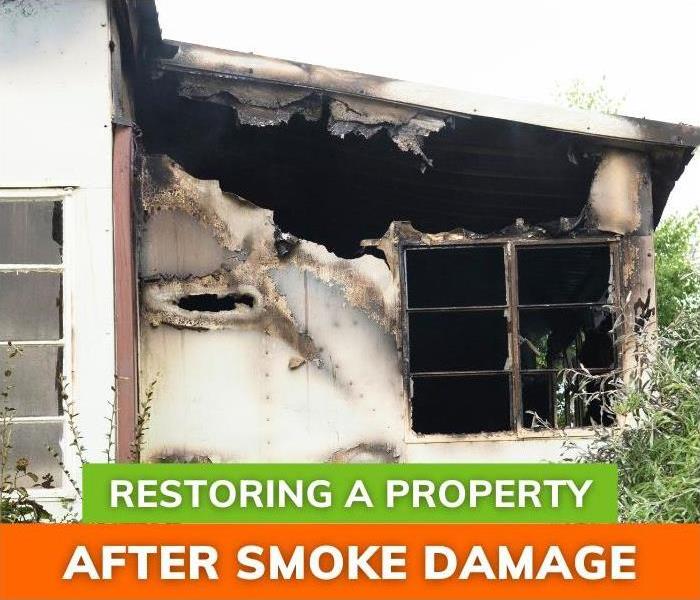 House damaged caused by fire
House damaged caused by fire
Steps to Restore a Property After Smoke Damage
A fire at your home or business can be one of the most frightening and traumatic experiences you’ll ever go through. In addition to the danger structure fires pose, they often result in the loss of property, some of which may include irreplaceable memories.
In addition, the lasting effects of water, fire, and smoke damage can lead to ongoing issues like structural instability, bad indoor odors, discoloration of interior spaces, and mold growth. While your safety and the safety of loved ones should always be paramount when picking up the pieces after a fire, there are some things you can do to make the restoration process easier.
If you’ve experienced the damaging effects of a home or business fire and you’re not sure of your next move, below are some steps to restore a property after smoke damage:
Be Mindful of Structural Stability
Because your safety is of the utmost importance and fires can weaken structures, never enter a structure that has experienced fire or water damage until it has been inspected by a qualified professional. Even if an area looks safe, hidden damage may be present if water, flames, and smoke have penetrated walls, flooring, and ceiling areas.
When these areas have been affected, you may not realize how weak a supporting wall or piece of flooring is until it fails. When it comes to damage restoration after a fire, your first goal should always be to secure the property before beginning to deal with things like smoke odors. While smoke and soot are bothersome and should be addressed, you need to make sure the affected area is safe to enter before you can begin the process of remedying a damaged property.
Contact Your Insurance Company
When possible, you should try to inspect structural damage in a safe manner, but you’ll also want to contact your insurance company to discuss the claims process. Insurance companies can tell you which parts of the structure are covered for loss and can walk you through the insurance claims process.
If possible, take photos and video of any damage you can see. Once again, be mindful of structural stability, and never place yourself in harm’s way when trying to assess the extent of the damage. If required, your insurer will send someone to your home or business to officially document any damage for the claims process.
Keep in mind that the insurance claims process can be lengthy, so you may need to make alternate plans to address immediate concerns. Depending on the extent of the damage, you and your loved ones may need to vacate a property until it can be properly inspected and repaired by a professional.
Document any work you have completed on the structure while going through the insurance claims process. This can help you and your insurer keep track of all payments made pursuant to any claims.
Work With Restoration Professionals
Although you can do things like install air scrubbers to remove odors in a fire-damaged home or business, most people benefit from partnering with fire and smoke damage restoration professionals to alleviate major issues. Companies that specialize in water damage restoration can take care of wet cleaning and smoke odor remediation, and most also provide thorough inspection and cleaning services for hidden dangers like mold.
As an added bonus, these companies have specialized tools and equipment to restore structural elements damaged by water used to put out a fire. Water damage restoration is often an involved process since moisture can seep into walls, flooring, and other areas of a home or business.
Simply drying affected areas is not enough, as damage may affect various layers of surfaces. Professional damage restoration services experts are able to take care of smoke and water damage on the surface, but they’re also able to clean and restore areas that may not be seen by the naked eye.
Be Mindful of Cleaning Products
If you choose to clean some of your property on your own, be mindful of which cleaning products you use. While cleaning is one of the steps to restore a property after smoke damage, not all cleaning products are designed for safe use on surfaces damaged by fire, smoke, and water. Some cleaning products may react to changes in a surface’s chemical composition following damage, and this can cause a cleaning agent to cause further damage.
If you use cleaners, try to use products that contain natural ingredients. It’s also a good idea to review the directions of any products you use and consider contacting the cleaner’s manufacturer to inquire about usage.
You’re also encouraged to test any cleaning products in an inconspicuous area before using them in larger areas. This approach can help you avoid creating a bigger problem if the cleaning product is not safe to use on surfaces damaged by fire, smoke, or water.
Always Put Your Safety First
While there are several steps to restoring a property after smoke damage, your priority should always be safety. In addition to structural instability, fire-damaged structures may contain additional dangers like fumes, leaking gas lines, smoldering embers, and debris in the air. Wear protective clothing, including eye protection and a respirator, when entering a damaged structure.
Consider contacting your utility provider before entering a home or business damaged by fire to see if an inspection is recommended. Your provider may send out a representative to review the integrity of things like gas and water lines to prevent future problems.
Contact SERVPRO® of Arcadia for Smoke Damage Restoration Solutions
If you’ve experienced a fire at your home or business in the Arcadia, CA, region, trust the experts at SERVPRO for relief. Our team provides expert restoration solutions for smoke damage, smoke odors, and fire damage, and we can also help remediate a mold problem left behind after water damage.
Fire Safety Tips for Property Managers
12/8/2024 (Permalink)
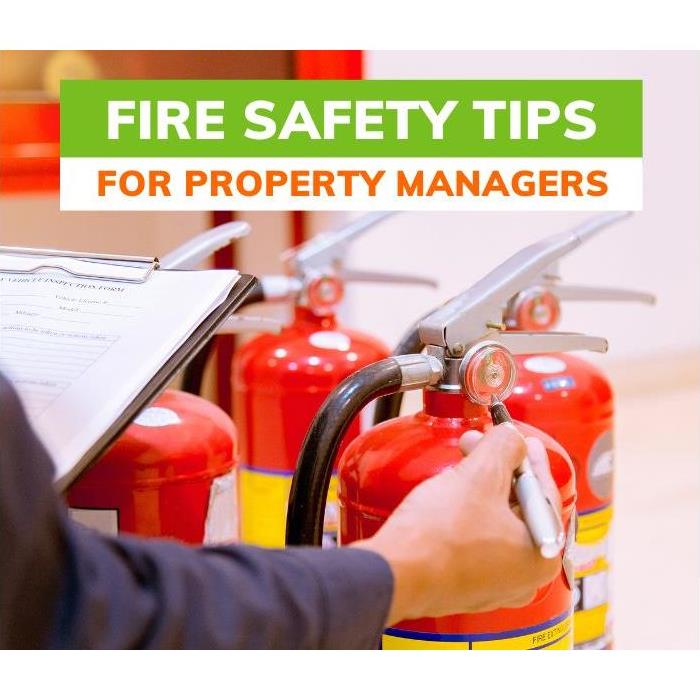 Fire extinguisher inspection
Fire extinguisher inspection
Fire Safety Tips for Property Managers
Maintaining fire safety in residential and commercial properties is not just a legal obligation but a crucial responsibility for property managers. Whether ensuring fire equipment is in working order or educating tenants on best practices, fire prevention can save lives and protect investments. The following fire safety tips will help property managers minimize the risks and prepare a building for the unexpected.
1. Regularly Inspect Fire Safety Equipment
Fire extinguishers are critical components of a fire safety system, including sprinklers, smoke detectors, and fire alarms. Regular inspections ensure these devices are functional and ready for emergencies.
Ensure fire extinguishers are also easily accessible and properly mounted. Employees and tenants should know where extinguishers are located and how to use them. The fire alarm system should also undergo inspection and maintenance by certified personnel at least once a year, as early detection is crucial in controlling fires. Test smoke detectors monthly.
Installing and maintaining systems for fire suppression, including sprinklers and fire-resistant doors and walls, is critical. Property managers should work with fire safety professionals to confirm that these systems are functioning properly and up to code. Adequate fire suppression can contain or extinguish a fire before it becomes uncontrollable, potentially saving lives and property.
Property managers should replace faulty equipment immediately to comply with safety regulations. They must also keep detailed records of maintenance, checks, and repairs related to fire safety equipment.
2. Keep Emergency Exit Routes Clear
One of the essential fire safety tips for property managers is keeping clear emergency exit routes, a cornerstone of fire safety. This action can make all the difference in ensuring a safe, efficient evacuation during an emergency.
Property managers should frequently perform walkthroughs of every evacuation path to confirm that all exits are fully operable and free from obstructions like debris, storage items, or misplaced furniture. It’s equally important to ensure that all emergency exits are marked with illuminated or reflective signs that occupants can easily spot in well-lit and low-visibility conditions.
Post clear maps in lobbies, hallways, and other common areas to guide occupants to the nearest exit in an emergency. These maps should be regularly updated to reflect structural changes in the building. Lastly, it’s essential to train staff to enforce rules about keeping exit routes clear and to ensure they understand the significance of these regulations for the safety of everyone in the building.
3. Provide Fire Safety Training and Education
Educating staff and tenants on fire safety is critical. The U.S. Fire Administration (USFA) reports that approximately 74% of residential fires are caused by cooking.
Property managers should circulate information about common fire hazards, prevention actions, and proper use of fire safety equipment to tenants. Clear guidelines on evacuation procedures should also be provided.
Organizing annual fire drills for residential and commercial properties helps reinforce evacuation procedures. Staff should receive additional training to recognize fire hazards and report them promptly. Encourage tenants to participate in fire drills for their safety. Digital communications or flyers with fire prevention tips can also be effective.
4. Property Maintenance Routines
Routine property maintenance is a crucial aspect of any comprehensive fire safety plan. Regular inspections and upkeep can help spot potential fire hazards before they become serious, providing a proactive approach to fire prevention.
One key area to focus on is the electrical system. Overloaded electrical panels and short circuits can cause fires, so the system must be inspected and maintained regularly. Any reports from tenants about faulty appliances, outlets, or wiring should be handled immediately to prevent dangerous situations from escalating. Neglecting these issues can increase the chances of an electrical fire.
In addition to electrical maintenance, it's important to schedule regular servicing of the HVAC system. A malfunctioning or overworked HVAC unit can pose significant fire risks by overheating or placing too much strain on the building’s electrical system. Routine HVAC check-ups will help ensure these systems operate safely and efficiently.
Property managers should also look for storm damage, which can expose electrical wires or cause other structural issues that might increase fire risks. It’s also essential to store flammable materials, such as mulch or other landscaping elements, well away from the building’s perimeter to reduce the chance of accidental fires.
5. Have a Fire Evacuation Plan
Every property should have a comprehensive fire evacuation plan that includes emergency procedures, locations of evacuation maps and fire extinguishers, and staff responsibilities. Assign fire wardens to assist with evacuations and ensure the plan addresses the needs of all occupants, including those with visual or hearing impairments.
Share the fire evacuation plan with new tenants upon move-in and employees as part of their onboarding process, and revisit it regularly to update it as needed.
6. Install Fire-Resistant Building Materials
Fire safety tips for property managers include using fire-resistant materials during renovations or new construction. These specialized materials can slow the spread of fire, giving occupants more time to evacuate and reducing property damage.
Fire-resistant materials include concrete, treated wood, and gypsum board, which can be used to enhance the safety of older buildings. Fire-rated doors can also slow the spread of fire. The property manager should conduct regular inspections to check for wear and tear of fire doors, and replacements should be made as necessary.
7. Implement Fire Hazard Policies
Creating fire-hazard policies is essential for protecting occupants in multi-unit and multi-story buildings at higher risk. Policies should prohibit using space heaters and open flames, like candles, in non-designated areas.
Tenants should also be restricted from storing gasoline or other flammable liquids on the property. Implement a reporting system so tenants can notify property managers of fire hazards and enforce strict penalties for violating fire safety rules.
8. Use Proper Signage
Proper signage is crucial for fire safety, and here's another fire safety tip for property managers: Install “No Smoking” signs in designated areas and use illuminated or reflective signage to mark evacuation routes clearly.
Evacuation maps and emergency procedures should be posted in visible locations like lobbies and next to elevators. Rooms containing fire safety equipment should be clearly labeled, and all signage must meet local fire code requirements for visibility and placement.
9. Keep Updated on Local Fire Regulations
Property managers need to keep informed about local fire safety regulations to ensure compliance and reduce legal liability. Review fire safety laws regularly for changes that could affect the property. Attend fire safety courses designed for property managers to stay up-to-date on best practices. Collaborating with local fire departments is also essential to address compliance issues promptly and effectively.
Fire Safety is a Great Property Management Habit
Fire safety is an ongoing commitment for property managers that requires regular maintenance, proper training, and adherence to local regulations. By staying proactive and implementing these fire prevention strategies, property managers can help safeguard their properties and their occupants. For support in fire safety measures and restoration after an incident, trust SERVPRO® restoration to get the job done right. Contact us today!
Creating a Fire Evacuation Plan for Your Building
10/28/2024 (Permalink)
 Evacuation Plan
Evacuation Plan
Creating a Fire Evacuation Plan for Your Building
A comprehensive plan to handle fire evacuation is crucial for ensuring building occupants' safety during emergencies. You can establish an efficient and effective response strategy by following a series of steps to create a fire evacuation plan for your building.
1. Assess the Building Layout and Fire Risk
Before you can create an effective fire evacuation plan, it is essential to understand the building's structure and any potential fire hazards. Review the building's layout, including the location of stairwells, exits, and corridors with no exits. Identify common fire hazards such as cooking areas, electrical equipment, and storage rooms.
Additionally, note any flammable materials in the building and open areas that could allow fire to spread quickly. Consider other structure characteristics, like the number of floors and whether the building is a high-rise or has many large, open spaces. Ensure up-to-date floorplans or blueprints are available for analysis while building a comprehensive evacuation plan.
2. Designate Evacuation Exits
Establishing primary and secondary exits and marking them is essential to guide occupants to safety in a fire situation. Identify all usable building exits, ensuring each area has at least two routes. In the evacuation plan, prioritize exits that lead occupants directly out of the building to a safe location or assembly point outdoors.
Elevators are unreliable in emergencies, so prioritize stairwells in the evacuation plan. Consider the needs of occupants with disabilities, and plan to use evacuation exits accessible to everyone. Mark exits with lighted signage and ensures it can be seen from all angles.
3. Plan Evacuation Routes
Identifying detailed evacuation routes lays a foundation for creating a fire evacuation plan for your building. Planned routes ensure occupants know how to escape safely in an emergency. In addition to primary evacuation routes, identify alternate routes in case any exits become blocked during an emergency. Map out the routes for each building floor, with clear paths that lead occupants to the primary and secondary exits.
During a building exit, ensure that the evacuation routes do not take occupants through hazardous areas such as boiler rooms or kitchens. Additionally, if the building has had previous fire incidents, ensure the property has been inspected for visible signs of damage and mold, which could create issues for future evacuation efforts. Promptly addressing these issues ensures that all routes remain safe and usable for fire drills and emergencies.
Display maps of evacuation routes prominently, placing them in high-visibility areas like corridors, elevators, and lobbies. On the maps, mark designated safe areas inside the building where occupants can gather to wait for assistance if they cannot immediately exit the building.
4. Plan for Special Needs and Assistance
Not all occupants can evacuate from the building in an emergency without assistance or at the same pace, so build additional accommodations into the plan. Identify individuals needing evacuation assistance, such as pregnant women, disabled, or elderly building occupants. Assign trained evacuation monitors who know the exit routes and procedures to help those with mobility issues.
Identify and map out areas where those unable to use the stairs can wait for help. Some building occupants may have visual or hearing impairments. The plan should include sound-based alarms and tactile evacuation maps to accommodate them. To ensure occupants know how to work together in an emergency, conduct regular fire drills and simulate evacuation procedures for those who need additional help.
5. Assign Roles and Responsibilities
Creating a fire evacuation plan for your building relies on teamwork for its success, which includes having designated personnel to guide occupants and assist them during an emergency. Appoint a floor captain or fire warden for each building floor to guide people along the evacuation routes in an emergency. Assign additional people as backups if the primary floor captains are unavailable or affected by the fire.
Designate and train personnel to perform essential tasks during a fire, such as turning off utilities and closing fire doors. Ensure the team knows the building’s layout and evacuation plan procedures. Develop a clear protocol for communication between the floor captains or wardens, building management, and fire emergency response personnel.
6. Establish a Fire Alarm and Notification System
Time is critical in an emergency response plan, and rapid notification ensures prompt evacuation with less confusion during a fire. Install fire alarms on each building floor, ensuring they are loud enough for occupants to hear throughout the building. Include strobe lights or other visual alarms for deaf and hard-of-hearing individuals.
Set up an automated alert system to ensure occupants receive emergency notifications. The system should transmit emergency alerts via phone, text, or email. Install fire alarms that can be activated manually in areas near fire exits or by equipment such as fire extinguishers or hoses. Design the alarm system to automatically alert the local fire department in case of a fire emergency.
7. Establish an Emergency Communication Plan
In emergency situations, clear, consistent communication is essential to let everyone know where to go and what to do. Develop a method for announcing evacuations over loudspeakers and create pre-written scripts to prevent confusion or panic under pressure.
Ensure a mass communication system, such as text alerts, is set up to establish lines of communication with security, building management, and emergency responders. Additionally, emergency communication devices like radios or phones should be included and kept accessible to floor captains and other evacuation team members.
8. Designate Assembly Points
Designate assembly points that are safe from the building and other potential fire hazards. Set up several for larger buildings with many occupants. Assign personnel to take headcounts and create a plan to locate missing individuals who are not present at assembly points. Promptly relay headcount information and coordinate with emergency responders to ensure all occupants are safe and accounted for.
9. Implement Training and Fire Drills
Conducting regular fire drills is an essential step in creating a fire evacuation plan for your building. Schedule drills at least twice annually, using different scenarios and times. During drills, instruct occupants on safety protocols, evacuation routes, and assembly points.
Provide training on how to use fire extinguishers and where to locate additional fire safety equipment. Simulate a genuine emergency and debrief afterward to review how the drill went and what needs improvement.
10. Maintain and Update the Fire Evacuation Plan Regularly
An evacuation plan needs to be revisited and updated to reflect building and occupant changes; otherwise, it will become less effective over time. Review the plan each year or after any significant occupancy or building changes. Integrate feedback from previous fire drills to refine and improve the plan.
Inspect all alarms, evacuation signage, and emergency lighting regularly to ensure they work correctly. Meet periodically with fire wardens and other personnel on your safety team to review roles and procedures. Finally, brief new tenants or occupants on the fire evacuation plan when they move into the building.
Ensure a Safe and Successful Evacuation in an Emergency
Creating the right plan for an efficient fire evacuation requires thoughtful planning, thorough training, and regular updates. By preparing for different scenarios and ensuring clear communication channels, building occupants are better protected in emergency situations. If your building has mold or water damage, our SERVPRO® restoration professionals can handle it before it becomes an emergency. Call us for more information today!
Essential Tips to Protect Your Home From Wildfires
7/16/2024 (Permalink)
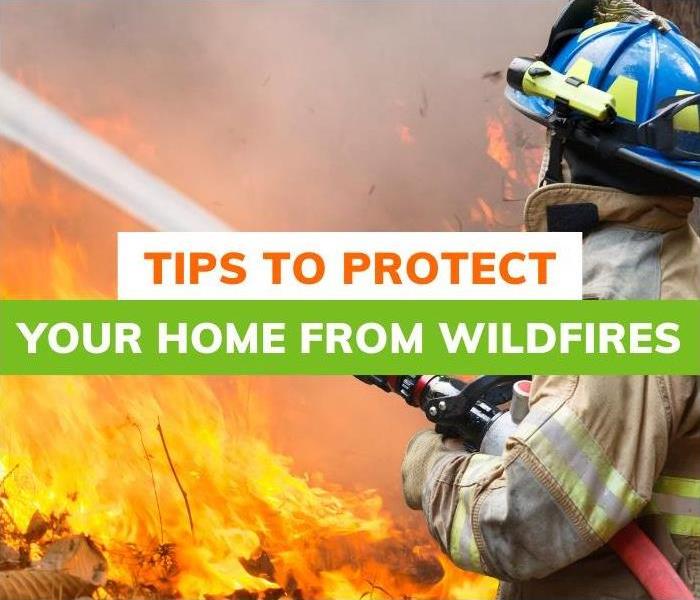 Firefighter Hosing a Wildfire
Firefighter Hosing a Wildfire
Essential Tips to Protect Your Home From Wildfires
Creating a safety zone to fire-proof your home and yard can keep your family and valuables safe from damaging wildfires. Implementing some effective yet simple tips can increase the chances of preserving your house during fire season, ensuring you can enjoy it with family and friends for years to come.
Defensible Space is Essential
One of the most important strategies to protect your house from wildfires involves creating a defensible space around the perimeter of your home. This buffer zone can prevent fire from reaching your house. The space around your house should be free of flammable materials. Start by clearing vegetation, which removes dead plants, pine needles, dry leaves, and other organic debris from your yard.
Prune trees with branches hanging over your house and perform additional trimming to make or keep space between the other trees on your property. Enhance your yard with fire-resistant trees and shrubs, planting them so they will have a safe distance between them even when fully grown. Keep your lawn regularly mowed; do not let the grass height exceed four inches.
Use Building Materials With Fire-Resistant Properties
If sparks or embers land on your home's roof, it could catch fire, depending on the roofing materials used. Class-A fire-rated materials such as tile, asphalt, or metal shingles are the best types of roofing to protect your home from fire. Instead of wood siding, choose fire-resistant materials such as brick, stucco, or fiber cement siding.
Add additional protection by installing double-pane windows or tempered glass to reduce the heat that could penetrate your home if a fire is nearby. For decks and patios, use fire-resistant building materials and avoid combustible decking. Some plastic and wood-plastic composites are potentially combustible and should be replaced with ignition-resistant or solid materials like concrete. Consider applying a fire-retardant treatment to any wood roof shingles or other vulnerable areas of your home's structure.
As an additional layer of safety, have fences, gates, and any other attachments built from fire-resistant materials, and ensure that garages have fire-rated doors and walls. Fire-resistant doors are also available, adding extra protection, but they must be appropriately sealed to ensure they function as intended. The doors are designed to stop smoke, flames, and, in some cases, conductive and radiant heat transfer.
Install Devices to Arrest Sparks
Cozy fires are lovely on a cold night or a balmy summer evening, but sparks and embers can fly out of the chimney, land on leaves, dry grasses, or trees, and start a fire. To ensure your home is safe, fit all your chimneys and stove pipes with chimney caps with approved spark arresters. They should have fine-gauge screens made of fireproof mesh. Spark arresters should also be used on vents from the attic, foundation, and soffit.
Regularly inspect and clean spark arresters to ensure they remain unclogged and function as intended. Local building codes and standards may dictate the type of spark arresters you must use, so ensure you are in compliance when making your choice. Chimneys, vents, and soffits should also be regularly inspected for damage.
Create a Zone of Fire-Resistance for Protection
You can protect your house from wildfires by making simple changes to the yard and land surrounding your home. Remove combustible or flammable materials close to the house, keeping them at least 30 feet away from structures.
Wood chips are commonly used as mulch in landscaping but are combustible, so consider switching to mulch using non-combustible items such as gravel, rock mulch, or pavers in your yard. For outdoor furniture, consider choosing items made of metal or other non-combustible materials, and use seat cushions and pillows that use fire-resistant fabrics for your decks and patios. Aside from trees and grass, choose low-growing, fire-resistant plants in your landscaping to maintain a zone around your home that will not fuel a fire.
Keep Roofs and Gutters Clean and Maintained
To reduce the amount of available fuel during fire season, it is essential to clean gutters and roofs regularly by removing built-up needles, leaves, and other organic debris. Additionally, you can install non-combustible gutter covers or metal mesh screens to guard the gutters and prevent any material inside them from catching fire. Routine maintenance can also prevent storm damage, ensuring that your gutters and roofs are in good repair to effectively manage debris and heavy rainfall. Catching potential roof storm damage early avoids complications that might otherwise exacerbate fire hazards.
It is a good idea to have a roof inspection to check for any gaps or damaged shingles and have them repaired, preventing flying embers from entering. Any downspouts from the roof should be inspected to ensure they are clear, do not have impacted leaves or needles, and are directing water away from the house.
Keep Firefighting Equipment On Hand
Depending on where you live and the fire risk, keeping firefighting equipment on the property might make sense. At a minimum, you can protect your house from wildfires by having garden hoses long enough to reach all areas of your yard and keeping them connected and functioning. Also, sprinklers can help keep the ground damp and reduce the chance of igniting plants or grass.
Purchase fire extinguishers and keep them readily accessible in critical locations around your home, ensuring they are adequately maintained and work if needed. If you need to keep your home wet under threat of a fire, ensure that you have access to a reliable water source such as a well, pool, or cistern. Finally, you may want to consider a backpack fire pump, a portable pump, and a water tank that enables you to mount a quick response against any fire threat.
Have an Emergency Plan
Having an emergency plan for yourself, your family, and your pets is critical to getting to safety as quickly as possible in a fire. Identify evacuation routes, make sure you have multiple options, and practice them with your family.
Establish a way to communicate with each family so that you can stay in touch during the emergency and ensure that everyone understands the plan. Assemble an emergency kit with the essentials like water, medications, food, and important documents. Additionally, plan how you will stay informed to monitor alerts and local news regarding wildfire updates.
Participate in Developing a Community Plan
The neighborhood stands a better chance of making it through a fire event if everybody works together. Collaborate with your neighbors to prepare a wildfire preparedness plan as a community. You may consider joining a local neighborhood watch or creating one to dispense wildfire information and alerts.
Neighbors are invaluable for sharing resources like equipment and fire safety information to ensure everybody is better prepared. In the event of a fire, community members can work together to create fire breaks and maintain the buffer of defensible spaces to protect their homes.
Defend Your Most Precious Assets
Taking a proactive approach to making your house fire-resistant can save your property and, more importantly, save lives. In a fire, SERVPRO® restoration services can help get your house, yard, and life back to normal as quickly as possible. Contact our expert team today to see how we can help.
Most Common House Fire Causes
3/2/2022 (Permalink)
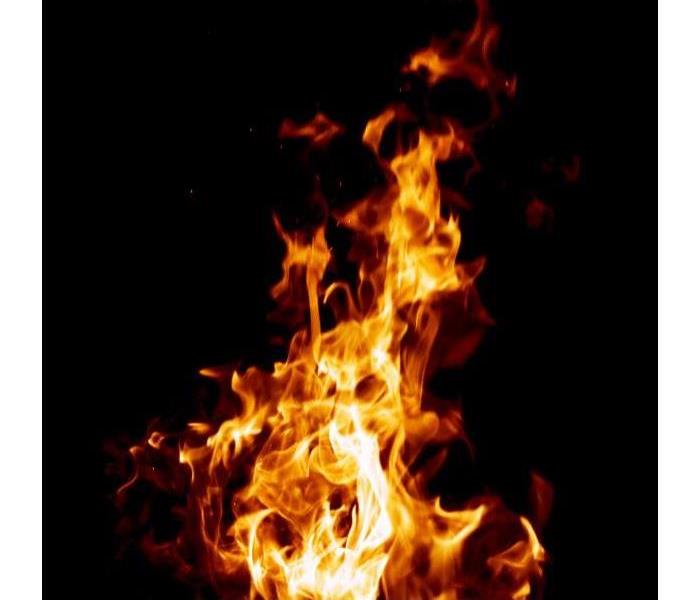 Most Common Home Fires
Most Common Home Fires
Tragic fires have no bounds, they spread quickly and give no mind to your personal items and documents. As a top restoration company SERVPRO of Arcadia will be there to help restore your home and structure as if it never even happened. In extreme cases, we even do our best to restore some of your most important documents back to normal! In any case, no one enjoys their home catching fire so let's go over the most common causes so you can avoid any tragedies.
Here are the Top 5 Causes of Fires:
- Cigarettes - The reason this is at the top of the list is because it can be tragic for the person smoking. Most times it is because a person fell asleep with one in their hand. Sometimes a smoker may throw a lit cigarette into dry plants.
- Cooking - Accidents happen all the time in the kitchen, a towel may catch fire, you may over cook your food, water and oil may mix and cause large fires, and even cooking in the oven and forgetting the oven on.
- Candles - Dropping one near flammable items or lighting one near towels and plants.
- Space Heaters - Leaving these unattended can be detrimental depending on the flooring in your home.
- Electrical Fires - Get your wiring checked once a year to check for shorts and faults. Sometimes these fires can cause huge damages and the start quickly because they are almost hidden.
Holiday Fires
12/2/2021 (Permalink)
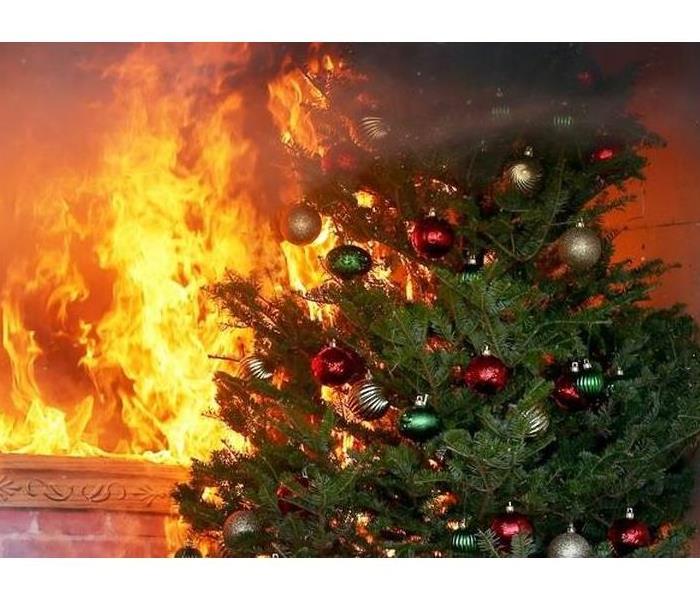 Keep your home safe during the holidays!
Keep your home safe during the holidays!
With Christmas only days away SERVPRO of Arcadia would like to share some tips to keep your home safe from any possible fire damages.
Your Christmas tree is the biggest factor to be aware of during this season, more so if you plan to have your tree up longer than a month.
- Make sure to always keep your Christmas tree watered and spray the leaves as well; tree fires most commonly occur when the tree is too dry.
- Keep your tree places away from all flames such as fireplaces, stoves, and space heaters.
- Be sure to keep candles away from your tree at all times.
- Try not to use more than 3 stands of holiday lights in order not to over load the outlets.
As always, SERVPRO of Arcadia is open 24/7 even on Christmas to help in the unfortunate event of fires, water damages and more. Call (626)447-4128 for any questions or assistance.
Facing a Fire
11/9/2021 (Permalink)
When facing a fire in your home it can be stressful or even scary to say the least. In fact, it is very important to get started on the clean up so that your home can still be put right back together!
When we say begin the clean up we don't mean go out and get a mop and cleaning supplies! This type of clean up calls for professionals who specialize in fire restorations.
Our SERVPRO teams are highly trained in fire restoration and will take care of everything necessary. Please, do not take matters into your own hands and try to start the clean up on your own. You can actually cause more damage by cleaning on your own. Not to worry, SERVPRO will make it as if It never even happened!
Halloween Fire Safety
10/4/2021 (Permalink)
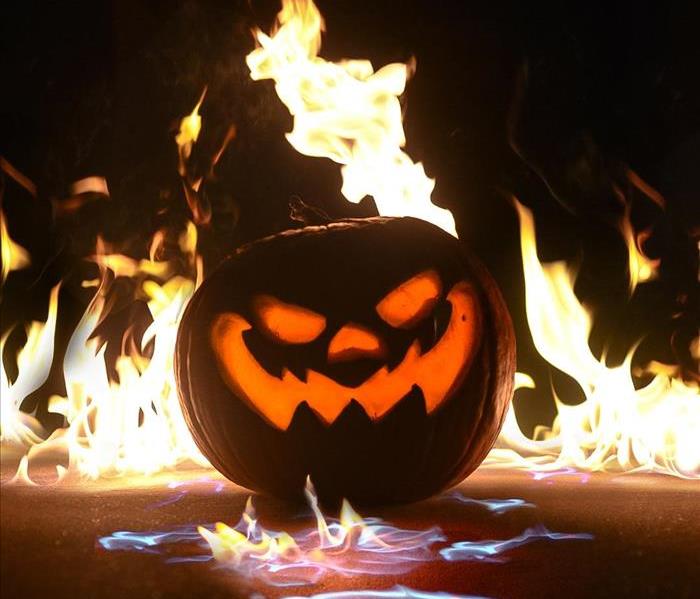 Safe ways to keep it spooky on Halloween!
Safe ways to keep it spooky on Halloween!
Carving pumpkins with the family, children trick-or-treating, dressing up in festive costumes are all the best parts of celebrating Halloween! BE WARE of possible fire hazards from these fun but dangerous festivities.
Here are some tips to keep your home safe this year:
- Swap out the old fashioned fire candle to light up your Jack-O-Lantern with battery powered candles or glow sticks
- If you do end up using fire candles please keep them away from any drought tolerant pants or fires.
- For the trick-or-treating children: teach them to stay away from lit pumpkins, do not kick them or move them in anyway
- Use a flashlight when out getting your sweet treats!
According to the National Fire Protecting Association (nfpa.org)
- From 2014-2018, an average of 770 home structure fires began with decorations per year.
- More than two of every five (44%) of these fires occurred because the decorations were too close to a heat source, such as a candle or hot equipment.
- More than one-third (36%) of these fires were started by candles.
- More than one-fifth (22%) of the decoration fires started in the kitchen; 16% began in the living room.
Source: NFPA Applied Research
For more tips on Halloween safety visit; https://www.nfpa.org/Public-Education/Fire-causes-and-risks/Seasonal-fire-causes/Halloween
Kitchen Fire
8/25/2021 (Permalink)
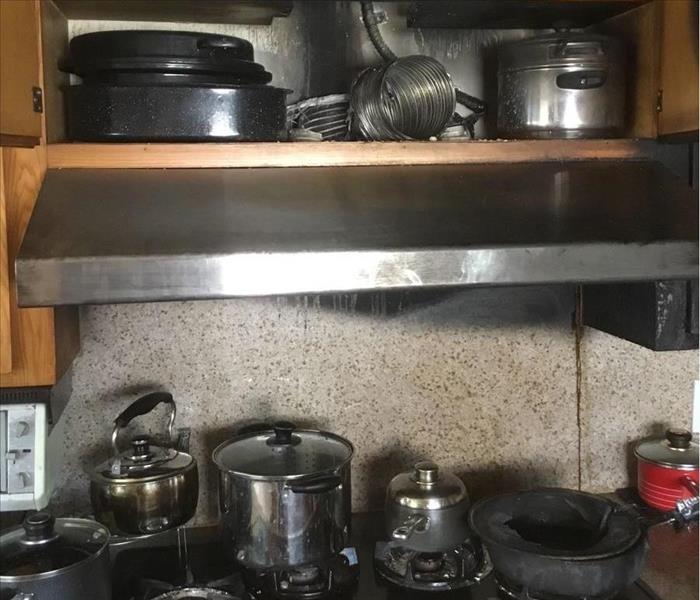 Kitchen stove caught fire
Kitchen stove caught fire
Kitchen fires in California are very common. The homeowner’s kitchen shown in this picture, suffered a fire damage which started from the stove. The cabinets surrounding the stove became covered in soot and smoke residue. Fortunately, the fire was taken out quickly with the help of the fire department.
Fire damage leaves behind strong odors, smoke residue and soot which can be challenging for the homeowner to clean on their own. By calling SERVPRO of Arcadia, the homeowner was at ease knowing the cleanup was being professional managed.
When you are faced with a fire disaster, remember SERVPRO of Arcadia is by your side. We have technicians that operate 24/7 to assist with emergency situations. Call SERVPRO of Arcadia in your time of need at (626) 447-4128.
We can make it “Like it never even happened."
Common Causes of Fire Damages
7/9/2021 (Permalink)
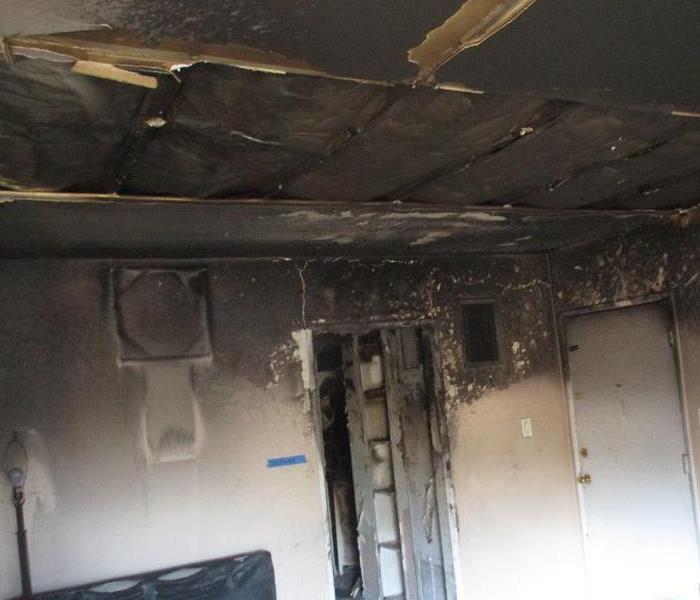 House fires caused by electricity are some of the most dangerous fires. Check out this blog for tips to prevent this.
House fires caused by electricity are some of the most dangerous fires. Check out this blog for tips to prevent this.
With fire season quickly approaching, we here at SERVPRO of Arcadia wanted to share some information with our community. It is so important, especially here in California, to be prepared for a fire in your home. Most fires we encounter are accidental, but here are some tips to help reduce the damages these fires can cause.
Some accidental fires that occur are most commonly caused by:
- Cooking Equipment
- Heating
- Smoking in bedrooms
- Electrical Equipment
- Candles
- Curious Children
- Faulty Wiring
- Barbecues
That is why we strongly recommend taking full precautions, in order to keep your loved ones and property safe at all times. Here are some helpful tips:
- Never leave the kitchen unattended when the stove is on. Keep close watch of pots and pans that can quickly overheat and can potentially ignite a fire.
- Make sure heating equipment wiring is in good condition and have it maintained yearly. Place electric heaters at least one meter away from any objects and furniture.
- Avoid smoking indoors. Not only is smoking a health hazard but it is one of the most common causes of fires.
- Make sure all electrical equipment is functioning properly and all cords are intact. Using GFCI outlets are recommended to prevent electrical fires.
- Never leave candles unattended, especially around small children. Always remember to turn candles off after every use.
- Children can be very curious, it is important to keep them safe by removing any flammable substances from their reach.
- Replace faulty or damaged wiring.
- Extinguish barbecue grill flames after every use.
You Can Never Be Too Safe
1/21/2020 (Permalink)
A fire can happen on your property at any time. We here at SERVPRO of Arcadia provide around the clock services 7 days a week. If you need us, we'll be there. What separates us from other restoration companies is that, when we receive the call from you we immediately assemble a work crew and send them your way. As a SERVPRO employee, our priorities are to ensure the job is done right the first time and consistently update our client on the progress of the job. The reason we do this, is because more often than not your home is the biggest investment you make. Therefore, we do everything in our power to ensure the customers happiness and leaving it, "Like it never even happened."
Always Be Prepared
1/16/2020 (Permalink)
Experiencing fire damage can be a very stressful situation. The leading cause of fires in a home or business most commonly occur when cooking or smoking. Fires can also caused by heating units and/or electrical issues.
After any fire damage, your primary focus should be safety:
- Is it safe to stay in the home?
- Electrical hazards are some of the most prevalent concerns.
- Only do activities that are safe for you to perform.
Things you should do after a fire and smoke damage:
- Limit the movements in your home after a fire damage to prevent soot particles from spreading damage to upholstery and carpet.
- Place dry towels on rugs, upholstery and carpet in high traffic areas.
- If you turn off the electricity completely empty the refrigerator and prop doors open.
- To prevent soot from sticking to chrome on kitchen/bathroom faucets or fixtures protect them by applying a small amount of petroleum jelly or oil.
- Tape double layers of cheesecloth over air registers to stop particles of soot from getting in or out the HVAC system.
No one ever expects to experience a fire, but if it does occur you can count on SERVPRO of Arcadia. Our technicians are well trained to cleanup and restore your home and/or business. We are available 24-hours 7 days a week to help you get your life back together.
Key tips to guide you through the aftermath of a fire.
1/16/2020 (Permalink)
A fire in your home or business can be very devastating. After the fire trucks leave, your property will likely suffer from fire/smoke damage and also a widespread water damage from firefighting efforts. Here are some tips what to do after the fire.
- Limit movement in the home to prevent soot particles from being embedded into upholstery and carpets.
- Place clean towels or old linens on rugs, upholstery and carpet traffic areas.
- If electricity is off, empty freezer and refrigerator and prop doors open.
- Clean and protect chrome with light coating of petroleum jelly or oil.
- Wash houseplants on both sides of leaves.
- Change HVAC filter.
- Tape double layers of cheesecloth over air registers.
Call the professionals at SERVPRO of Arcadia to get the damage under control. WE are trained to clean and restore your home with as little disruption as possible.
Fire, Smoke, Soot, and Ash Cleanup
1/13/2020 (Permalink)
If you’ve ever experienced a home fire, then you know how devastating it can be. A house fire can cause a substantial amount of damage and is something no one should ever have to experience. Not only are they harmful to your home, the aftermath of a fire can also be a harmful to your health. However, if a fire were to occur, SERVPRO of Arcadia specializes in fire cleanup and restoration.
After a fire has occurred, smoke, ash, soot, and a smoky odor are most likely what’s going to be left behind. We advise you to just sit back and let the professionals handle the situation. Taking matters into your own hands may only make the situation worse and even cause extended health issues. Our crew members here at SERVPRO of Arcadia are highly trained and know exactly how to treat fire damage after it has occurred.
SERVPRO of Arcadia is here to help and answer any questions. Call (626) 447-4128, for any concerns you may have about a home fire.
New Years Awesome SAFETY Tips
1/11/2019 (Permalink)
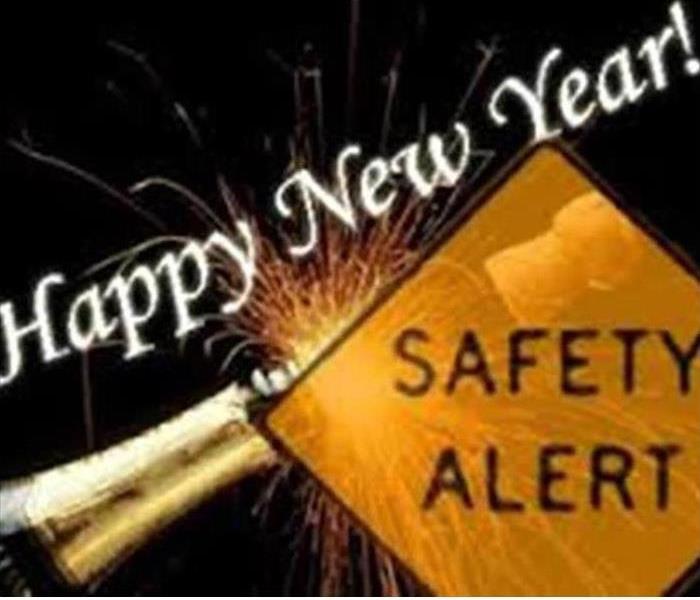 SERVPRO WILL ALWAYS BE HERE FOR YOU IN EVERY NEW YEAR!
SERVPRO WILL ALWAYS BE HERE FOR YOU IN EVERY NEW YEAR!
New Year's Eve celebrations
The new year comes up quickly. Lets get ready for the new year by educating ourselves on some safety tips. Many of the things we enjoy during this festive period, such as fireworks, Christmas lights, candles, paper hats and decorations. Did you know these things can all be fire hazards ?
Here are some tips to keep you safe this New Year
If you are planning to celebrate with fireworks, store them in a metal box, read the instructions, never go back to a lit firework and keep a bucket of water nearby.
- Contact your local Fire Department for more information as well. They are just handsome fellas to look at!
Never place candles near your Christmas tree or furnishings. Never leave candles burning unattended.
Decorations can burn easily - Don't attach them to lights or heaters.
Switch off electrical appliances when not in use, unless they're designed to stay on. Take special care with fairy lights and outdoor lights. Always switch off and unplug lights before you go to bed.
Check your lights conform to the British Standard. Always use an RCD on outdoor electrical equipment (safety device that can save lives by instantly switching off the power)
Never leave cooking unattended.
Check the battery in your smoke detectors and carbon monoxide detectors every week. Use the New Year as a reminder to clean it and remove dust, and maintenance them.
SERVPRO of Arcadia understands that New Year's celebrations are a time to have fun with family and friends! Read and follow the tips to help have a SAFE holiday!
Holiday Fire Safety Tips
1/4/2019 (Permalink)
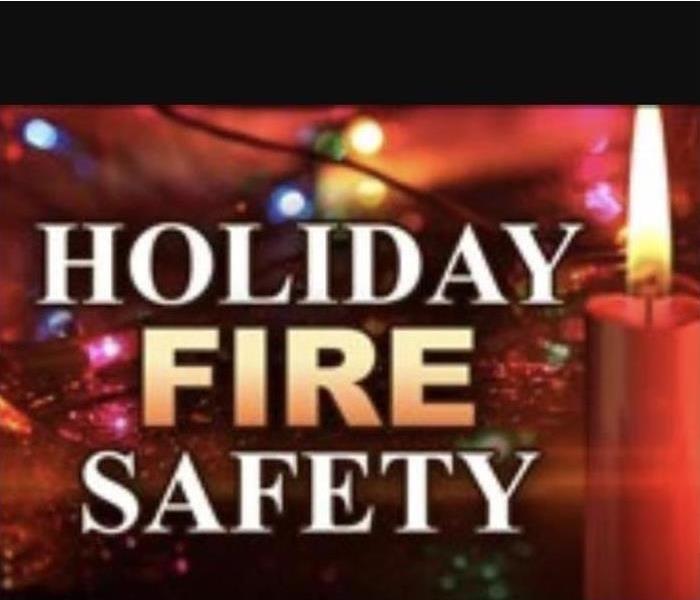 We got some great holiday tips!!!
We got some great holiday tips!!!
We all love the holidays. The holidays are a joyous time when we celebrate many festivities with our loved ones. Unfortunately, it is also a time when many accidental fires occur. We at SERVPRO want to help ensure our customers have a happy and safe holiday season. Here are some helpful tips to help keep you and your home safe:
• When selecting a Christmas tree make sure pine needles are green and vibrant.
• Water Christmas tree daily, the average tree requires about a gallon of water. This will help avoid drying out.
• If tree does dry out, do not plug in the tree lights.
• Do not leave tree lights on overnight.
• Keep Christmas tree away from heated surfaces such as fire places and heaters.
• Never leave lit candles unattended, especially around small children and/or pets.
• Always extinguish fire place after every use.
• Do not place any objects near heaters.
• When using the oven or stove, do not leave it unattended.
On behalf of our family at SERVPRO we would like to wish you and your family a Happy Holiday every year!






 24/7 Emergency Service
24/7 Emergency Service











